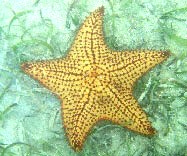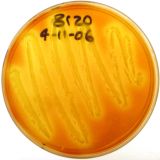- Home
- About S&T
- Taxa/Organisms
- Ecosystems
- Issues
- Methods & Tools
- Reports & Publications
- Location
- Search
Publisher: USGS | Science Center: Florida Integrated Science Center (FISC, Gainesville) | Format: URL
fl.biology.usgs.gov — The connection between fish habitat utilization, prey use, and fish movement patterns is not known in relation to available invertebrate prey resources in off-reef sites. Developing a better understanding of the habitat use, diet, and resource needs of benthic communities and their interactions with mobile fish and invertebrates is an important More...

Publisher: USGS | Science Center: Western Fisheries Research Center (WFRC, Seattle) | Format: URL
wfrc.usgs.gov — Since 1994, scientists from the Anadromous Fish Ecology Team have been assisting the U.S. Army Corps of Engineers (USACE) in evaluating the migration behavior and passage of juvenile salmon and steelhead through Lower Granite Reservoir and Dam on the Snake River, WA. The goal of this study is to identify the behavior of individual juvenile salmon More...

Publisher: USGS | Science Center: Western Fisheries Research Center (WFRC, Seattle) | Format: URL
wfrc.usgs.gov — The Arctic charr (Salvelinus alpinus) in the northern most latitudes migrate to the ocean in the spring to feed and grow. This results in accumulation of polychlorinated biphenyls (PCB) in their visceral fat. During the winter, the charr reside in freshwater lakes and do not feed. They do mobilize lipids from adipose tissue for energy, which More...

Publisher: USGS | Science Center: Florida Integrated Science Center (FISC, Gainesville) | Format: URL
fl.biology.usgs.gov — The African jewelfish (Hemichromis letourneuxi) has been established in canals surrounding the Miami area since the 1960s. With changes in water delivery to the park, the species has recently (2000) entered Everglades National Park and expanded its range westward through Big Cypress National Preserve. Simultaneously, African jewelfish from a More...

Publisher: USGS | Science Center: Western Fisheries Research Center (WFRC, Seattle) | Format: URL
wfrc.usgs.gov — Threatened and endangered salmonids in the Pacific Northwest often use backwaters and wetlands as they migrate toward the ocean, however our understanding of the role of wetlands to juvenile salmonids is limited. The major Objective of this study was to determine whether juvenile steelhead were being tapped on the wetland during spring, and More...

Publisher: USGS | Science Center: Florida Integrated Science Center (FISC, Gainesville) | Format: URL
fl.biology.usgs.gov — The Nile tilapia (Oreochromis niloticus) is commonly used in aquaculture worldwide. Feral populations exist in many regions where individuals escape culture and establish in natural habitats. In Mississippi, Nile tilapia are established in at least three distinct localities (fig. 1): the lower Pascagoula and Escatawpa river drainages, and a More...

Publisher: USGS | Science Center: Florida Integrated Science Center (FISC, Gainesville) | Format: URL
fl.biology.usgs.gov — Because the African jewelfish has a broad salinity tolerance, scientists tested how the species low-temperature tolerance varied at three salinities: freshwater (0 ppt), brackish (10 ppt) and marine (35 ppt) in the laboratory. A field experiment was then conducted to examine the survivorship of individuals when caged in several common aquatic More...

Publisher: USGS | Science Center: Western Fisheries Research Center (WFRC, Seattle) | Format: URL
wfrc.usgs.gov — Ballast water discharges are the most significant cause of aquatic biological invasions in coastal waters, including the Great Lakes. Currently, treatment of ballast water prior to discharge at the receiving port offers significant promise to help control this problem. However, development of treatment technologies is limited by lack of objective More...

Publisher: USGS | Science Center: Western Fisheries Research Center (WFRC, Seattle) | Format: URL
wfrc.usgs.gov — Over the past 150 years, land reclamation activities have resulted in loss of significant amounts of tidal marshes (sometimes referred to as inter-tidal wetlands, the estuarine zone that is alternately flooded and exposed) in San Francisco Bay and the Sacramento-San Joaquin Delta (Bay/Delta). Recently, in an effort to halt or reverse the decline More...

Publisher: USGS | Science Center: Biological Informatics | Format: URL
biology.usgs.gov — This page links to samples of genetics and genomics research from the USGS Biological Resources Discipline about the epidemiology of fish diseases.

Publisher: USGS | Science Center: Western Fisheries Research Center (WFRC, Seattle) | Format: URL
wfrc.usgs.gov — This U.S./Russian collaboration will investigate genetics and life histories of Kamchatka Peninsula rainbow trout and steelhead (O. mykiss), and Dolly Varden, white-spotted, and arctic char (S. malma, S. leucomaensis, and S. alpinus, respectively). Both anadromous and resident forms of these generally occur in Kamchatka rivers that are free from More...

Publisher: USGS (Biological Science Office) | Science Center: Alaska Science Center (ASC, Anchorage) | Format: URL
www.absc.usgs.gov — This project was designed to assess whether or not populations are recovering, whether isolated processes constrain recovery, and the potential activities to facilitate recovery. This web resource provides links to background information on Nearshore Vertebrate Predators, the Sea Otter, the Harlequin Duck, the River Otter, and the Pigeon More...
